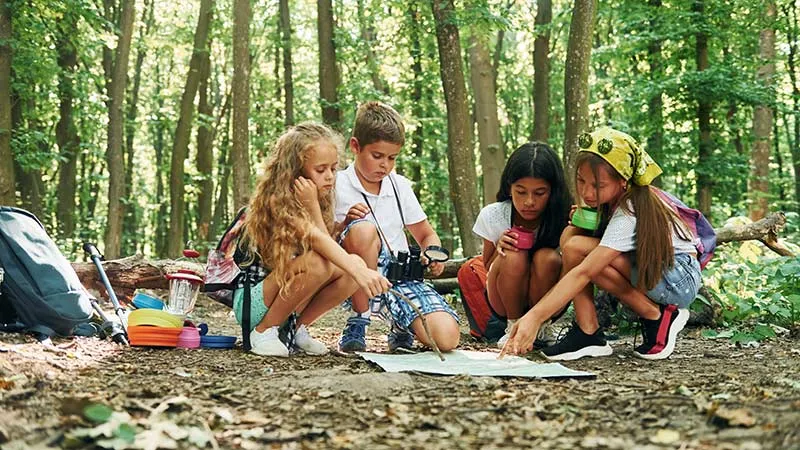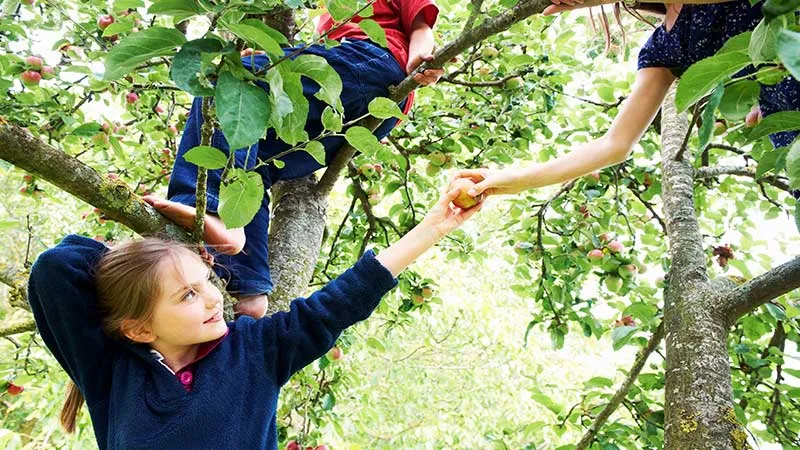Education and Training
What are the Benefits of Forest Schools – Top 10 Benefits
Forest School is a growing concept of education that follows a method of pedagogy different from traditional schools. This particular type of school believes in ‘learner-led’ activities instead of providing them with assignments and taking tests. The popularity of Forest schools is rising day by day, and its benefits are getting recognised as well.
This blog outlines the activities, principles and benefits of Forest Schools. Read thoroughly to understand what Forest Schools render to learners if this is comparatively a new term to you.
Table of Content
- What is Forest School?
- A Brief History of Forest Schools
- What are the Forest School Activities?
- What are the Principles of a Forest School?
- Forest Schools should provide sessions on a long-term basis
- Forest Schools should take place in a natural wooded environment
- Forest Schools should promote a holistic development for the learners
- Forest Schools should be risk-aware
- Forest School practitioners should be qualified
- Forest schools should be learner-centred
- What are the Benefits of Forest Schools?
- 1. Boosts Confidence
- 2. Develops Communication Skills
- 3. Improves Problem-Solving Skills
- 4. Creates Independent Learners
- 5. Increases Motivation and Concentration
- 6. Enhances Sensory and Motor Skills
- 7. Provides Environmental Literacy
- 8. Promotes Emotional Intelligence
- 9. Promotes Resilience
- 10. Helps Children with Learning Disabilities to Learn Better
- Conclusion
- What to Read Next:
What is Forest School?
The school that aims at early childhood education through play-based learning in an outdoor learning environment is a Forest School. Unlike traditional schools, forest schools encourage children to learn through experiential learning and allow them to choose activities that pique their interests.
The concept of Forest School is such that it does not have any planned activities for children like the conventional education system; rather, the learning is led by children’s own curiosity and interests in an unstructured way.
A key aspect of Forest Schools is the stimulation of the senses. Students are encouraged to use their five senses to learn by exploring the natural world. This ensures their cognitive development by decreasing their stress levels.
Forest Schools offer a holistic learning experience. This method of learning becomes more effective when attended long term. Those who enrol in Forest Schools should attend the sessions regularly. Therefore, it is recommended that the children attend the sessions at least once or twice in two weeks for a minimum of a year.
A Brief History of Forest Schools
You may not have heard about Forest schools before; this concept of education might be new to you. However, Forest school was introduced back in the 1950s. Scandinavia popularised the idea of Forest schools, while Ella Flautau created the first Forest school in Denmark in 1952.
Later on, the trend of Forest schools spread to Sweden in the 1980s. Today, Forest schools are not limited to Scandinavian countries only, it can be now found in countries like Australia, Germany, New Zealand, USA, UK and beyond.
The first Forest school in the UK was introduced in Devon in 1993, which was inspired by the success of outdoor learning in Denmark and wider Scandinavia. The popularity of Forest Schools continues to grow in the UK.
According to a 2021 survey by the Forest School Association (FSA), “Two-thirds of the UK Schools have noted an increase in demand for Forest Schools since the beginning of the pandemic in the spring of 2020. Some have even reported that they are completely booked for the foreseeable future.”
So, how many forest schools are there in the UK? The number is still unknown. However, there are currently only 108 certified Forest School practitioners in the UK despite the growing popularity of this particular type of school.
What are the Forest School Activities?
Practitioners in a Forest School consider the interests of the learners and the type of activities that would be particularly beneficial for the children. The activities are centred around play and every activity provides a learning opportunity.
Forest School activities might include the followings:
- Creative activities using natural products such as mud, leaves and sticks for artwork
- Growing plants, vegetables, flowers and fruits.
- Use of tools such as knives, hammers or fire.
- Bushcraft and survival activities like building shelters and foraging.
- Treasure hunts.
- Tree activities such as learning to measure the height and age of a tree, identifying tree species and building a bird’s nest.
- Animal activities that include animal tracking, bird surveys, identifying insects and creating habitats.
- Sensory activities that focus on some or all of the five senses.
- Outdoor activities like cooking on campfires, den building and so on.
What are the Principles of a Forest School?
The principles of a Forest school are based on the fundamentals of enabling the children to learn through nature-based activities, develop a meaningful connection with the world and solve real-life issues with confidence.
Forest Schools have six guiding principles as approved by the Forest School Association (FSA), which are-
Forest Schools should provide sessions on a long-term basis
One thing to be noted is that Forest School sessions should be regular and over a long period of time. The FSA suggests each session to extend for at least 24 weeks, with at least two terms having a minimum of two hours per session. This duration is required to establish trust between practitioners and learners and for self-reflection of the learners.
Forest Schools should take place in a natural wooded environment
The sessions should take place in a natural setting surrounded by trees so that the learners can bond with nature. This setting would provide the students with the space and environment to explore and discover.
Forest Schools should promote a holistic development for the learners
A holistic development means the overall development of a learner that includes the emotional, intellectual, spiritual and social development along with the physical one. Forest schools should aim at developing all these aspects among a learner in a low-intervention manner. The children should not be guided to think in a certain way; they should be allowed to self-discover instead.
Forest Schools should be risk-aware
Learning through playing, exploring and trying things out are the benefits of Forest Schools. Practitioners suggest activities that focus on overcoming risks, challenges and problems. Children might be taught to use tools like knives and axes and how to light campfires as a part of their activity.
It is to be mentioned that risk in the context of Forest School is not just about the physical danger but also about social and emotional risk. For example- confronting the fear of doing something silly or adapting to something new.
Forest School practitioners should be qualified
Forest school practitioners perform complex duties like facilitating the learners’ learning opportunities in the outdoor setting and providing support to face risks. Therefore, they need to be trained and qualified to run the sessions appropriately.
The FSA suggests that the practitioners should hold a Level 3 Forest School qualification, which enables them to achieve the skills required to run quality sessions. These include first-aid, practical skills, teaching skills, risk-benefit analysis, and environmental impact awareness. It also trains the practitioners to balance guidance and structured activities of Forest School.
Forest schools should be learner-centred
Since the Forest schools do not follow any structured curriculum like the traditional schools, they should have a learner-centred approach to meet the needs and interests of the learners. The learning should be a co-operative process between the learner and the practitioner that might include appropriate dialogue, observation, relationship building, reflection and communication.

SEN Teaching Assistant Level 3 Course
This comprehensive course is the perfect way to kickstart your career in the field of SEN – teaching. This course will give you a competitive advantage in your career, making you stand out from all other applicants and employees.
What are the Benefits of Forest Schools?
The benefits of Forest Schools have been recognised by parents, learners and practitioners long before. The benefits are long-lasting and can prove to be effective in early childhood as well as adulthood.
1. Boosts Confidence
The activities of Forest schools encourage risk-taking, use of certain tools, access to the natural world and learning through exploration. All these prepare the learners to face the real world with an increased confidence level.
2. Develops Communication Skills
Forest Schools involve scaffolding from practitioners, use of appropriate dialogue and collaborative work that can help to improve a learners’ communication skills.
3. Improves Problem-Solving Skills
Through hands-on experiential learning, learners discover how to assess problems and make decisions about the best way to solve them. This eventually prepares them to be confident at problem solving.
4. Creates Independent Learners
The practitioners of forest schools support children in their chosen activities and forms of play instead of presenting investigative questions. This allows the children to develop themselves as independent learners.
5. Increases Motivation and Concentration
The Forest School activities are designed in such a way that learners find them interesting and engaging. Learning through play results in higher interest levels, which improves a learner’s attention and concentration. In contrast to traditional schools, forest schools do not have assignments and exams, but students are praised for their activities and skill sharing. This appreciation motivates the students to perform better.
6. Enhances Sensory and Motor Skills
The outdoor activities performed by the learners in a Forest school focus on a variety of skills such as climbing, balancing, and sensory skills. The activities also involve walking, running or jumping. All these contribute to enhancing children’s motor skills.
7. Provides Environmental Literacy
One of the main features of forest schools is that it acquaints students with nature and lets them explore the world around them. Learners gradually grow a better understanding of nature and the environment. They also understand how we humans are benefited from nature which leads them to appreciate the wilderness.
8. Promotes Emotional Intelligence
Emotional intelligence is another benefit of forest school. It includes social skills, empathy, motivation, self-awareness and self-regulation. The children in a forest school have the opportunity to challenge themselves and reflect on their experiences.
This enables them to develop self-awareness and self-regulation. They also develop social skills and empathy when they share and listen to their peers in a group session.
9. Promotes Resilience
Resilience is an ability to recover from or adjust easily to misfortune or change. Research shows that simply being in nature can reduce the impact of stress.
So, children who spend more time in nature will have less stress, to begin with. Children attending forest schools will also be more independent as they lead their own learning. They make decisions around risks and become resilient in the process.
10. Helps Children with Learning Disabilities to Learn Better
Children who are unable to perform well in classroom settings or suffer from ADHD, Forest schools encourage curiosity and motivation to them. The Attention Restoration Theory supports this claim as well.
Even children with speech difficulties, behavioural difficulties and autism can benefit from Forest school. These children can gain more independence, build resilience, and improve their communication skills through the activities of Forest Schools.
Though they might struggle initially, gradually, with the help and support of practitioners, they would embrace the forest environment for learning.
Top Courses of this Category
Conclusion
Forest schools can be an excellent medium of education for children who are unable to cope in classroom settings. Since the Forest school approach is a holistic approach, learners are benefited spiritually, emotionally and physically. As a result, those who attend Forest schools are confident, resilient and independent. So, without any doubt, we can say that the benefits of forest schools are multi-faceted.
Teachers who are interested in working with children and teaching them health, fitness, and functional skills can enrol in the Psycho-Physical Activity for Kid (PPA) Course. This course teaches you mobility drills, juggling skills and yoga drills, which are fun to share with your students as well.
What to Read Next:
- No articles found










